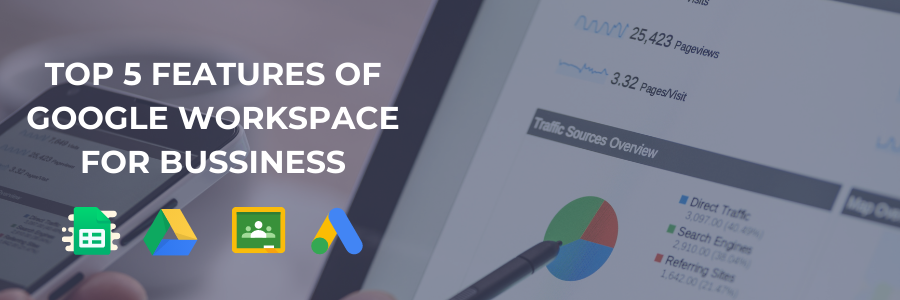Top 5 Features of Google Workspace for Business

What Is Google Workspace and How Does It Work?
Google Workspace, often known as G Suite or Google for Business, is a set of tools and apps offered by Google, with premium features available for a monthly fee. For years, Google has been hard at work developing a range of tools to assist people.
Google G Suite takes the free versions of Google Docs and Gmail a step further by integrating them into a single large package designed exclusively for enterprises. Google Workspace may be used by any organization, from a single freelancer to a major corporation, to create, collaborate, communicate, and be productive in a range of settings.
1. Gmail Client Supports Domain-Branded Email
Google Workspace allows you to utilize your own email domain in addition to all of the benefits of Gmail. It means Google Suite can offer you a premium, business-grade email account that you can manage and secure.
An Email server does not need to be installed or maintained. As your company grows, you can also add or remove email subscribers. You can send the same email to the same person at name@f60host.com, sales@f60host.com, or info@f60host.com because each Gmail user can have up to 30 alias accounts.
Another purpose of having Gmail for business communications is that consumers are likely to be familiar with consumer Gmail accounts. As a result, users can effortlessly move between personal and professional email accounts.
2. Using Google Drive to Store and Share Files
Google Drive is the cloud-based storage option that offers safe and secure access to Workspace-based files. Each user has a Google Drive account, which they can use to save their work.
To exchange files and resources, you can however create a Google Drive account with group access. You can manually grant access and assign read, comment, or write permissions to users outside your team if you want to share files with them. If the document owner forgets to include a user who requires access, they can email the document owner to request permission.
We don’t have to worry about losing your work when all of your data are kept in the cloud. Any changes to the file are automatically saved, allowing you to resume where you left off. With Google G Suite, you also receive plenty of storage. You can also upgrade your subscription plan to the Enterprise edition for limitless storage if your files are too large.
3. Google Docs for our Sheets
Google Docs is widely used, and the free version is nearly identical to the premium version. The Google Workspace version differs in that it offers additional security safeguards for safeguarding sensitive data.
You can also create a shared drive for team members and other users to collaborate on files. Furthermore, if you go offline, Google Docs functions with and without internet connectivity.
4. Work From Anywhere
Google Workspace enables automated account syncing across several devices, including your PC, phone, or tablet, for offline use. You may also browse and install Google Workspace-integrated ‘Work from anywhere’ applications.
You can hold virtual meetings with your team members using Google Meet and Google Chat. You may use Team Calendar to coordinate meetings and keep everyone’s schedules in sync. You can also edit documents, presentations, and spreadsheets in real-time with document collaboration apps like Google Docs, Google Sheets, and Google Slides while keeping track of changes made by others with version history.
Teams can use Google Currents to construct their own social network to streamline their work across the enterprise, share resources, and spark debates that will help your firm achieve its objective.
5. Backup Business Data Using Google Vault
In the event of data loss, data corruption, or potential legal issues arising from suspended accounts, Google Suite provides a fail-safe solution.
You can keep important data safe for as long as you need it with Google Vault. Even for suspended accounts and deleted documents, you can define data retention policies.
Data can also be found using Google’s search queries, which can be exported in printed formats. Backing up user data to track their queries, views, and overall user activity is an example use case.
